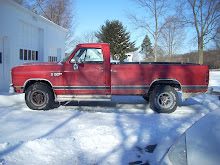Even though I had just bought a new paper filter, I just couldn't ignore the cheap performance of a K&N air filter. Last night I called the Advanced Auto in Colchester. They didn't have the OEM replacement in stock, but they could have it in the next day. Talk about service! I figured since I was driving out there to pick up the filter, that I would change the oil, since I really had no idea of the service history of the vehicle. After doing some research, I decided on Royal Purple synthetic 10W-30, and a WIX oil filter. Mark's United Auto Parts, also in Colchester, carries WIX filters and Royal Purple oil (Advanced Auto also carries Royal Purple). According to the Owner's Manual, the 318 takes 5 quarts. All told, just the oil and filter was over $60! I hoped it was worth the steep price, considering most dealerships charge less than $20 for an oil change.
Arriving home, I got down to it. First, I replaced the paper air filter with the K&N. I did this before backing the truck into the garage, to see if I could tell a difference in performance with the old oil still in the truck. I didn't notice any difference, but I wasn't really driving around, either. With the truck in position, I put the oil pan into place, grabbed my ratchet with 1/2" socket, crawled onto the creeper, found the drain plug on the back of the oil pan, and opened 'er up. After seeing what came out, I sure was glad I decided to change the oil when I did! Opaque, charcoal grey, viscous goop slowly drained out. Taking a look at the drain plug, I noticed a small rubber gasket. It was totally destroyed, and fell apart from some gentle testing with my finger. Being a Sunday night, all the auto parts stores were either closed, or so far away that they would be by the time I got to them. I had to use the truck tomorrow morning, so I needed to improvise. The Home Depot in town had O-rings, but no flat rubber gaskets of the appropriate size. Desperate, I set out to the Walmart in Rocky Hill. No gaskets, but at least some blue RTV. I returned home, cleaned off the drain plug and area around the drain with some mineral spirits, put a bead of RTV on the drain plug, and re-installed it tight, but not too tight, with the socket. I had to wait an hour for the RTV to set, so in the time being I figured I'd remove the old FRAM oil filter. Some jerk had previously over-tightened the damn thing (like every oil filter I've run across in my limited experience working on cars), so it took a strap wrench, a fair bit of cursing, and bending the hell out of the old filter to eventually coax it off. A quick 15 minute break to round out the hour, and I was ready to install the new filter and refill the sump. Filling the filter with about a pint of oil and pre-moistening the seal, I crawled back under the truck and did some more cursing as I attempted to install the filter without cross-threading while oil dripped down my sleeve. It seems all my vehicles have their oil filters in the most awkward places! After that goofiness, I finally reached the easy part. I opened the cap on the valve cover, stuck in the funnel, and poured in the other 4.5 quarts. Now was the real test. This was only the second oil change I've done on one of my vehicles, the first being on my 1995 Lincoln Town Car. Believe me, that is not a vehicle you want to try to change the oil on! It was a 3 hour fiasco, and I had help! This time I gave myself 50/50 odds. Either I would have no oil pressure, and $8.99 a quart oil spraying out from either an improperly sealed filter or the RTV'd drain plug, or it would be a complete success. Time for start-up. The oil light came on for a second, then shut off. A few more seconds... Whew! Running like a champ, and sounding much stronger, less like a farm tractor. No leaks on the ground. Time to take it around the block to see what the effects of the new oil and air filter would be on drivability. What a world of difference! Just from a non-scientific seat of the pants interpretation, torque really stayed the same, but now the amount of effort (butterfly position, engine RPM) required to accelerate up to a decent speed was drastically reduced, giving the driver more pedal to work with, and reducing stress on the engine. Also the engine actually responds when I floor the pedal. Before, it would just start to gradually accelerate.
In conclusion, the $115 I spent was well worth the increase in performance and drivability. Santa is finally becoming less of a pig, and actually enjoyable to drive. I fell good things down the road...
Subscribe to:
Post Comments (Atom)

No comments:
Post a Comment